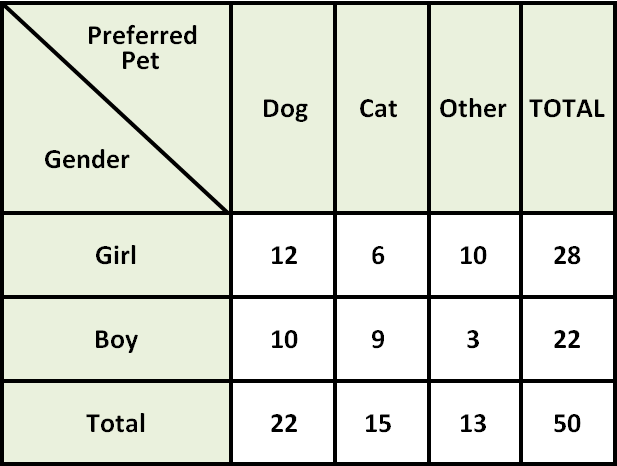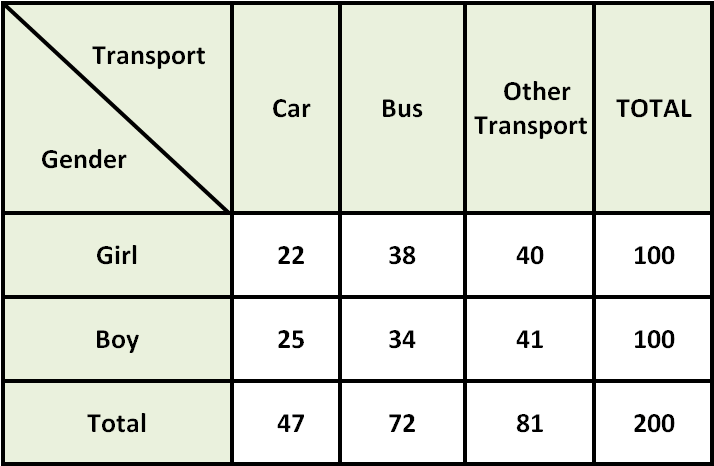HOW TO CALCULATE MARGINAL RELATIVE FREQUENCY
Marginal relative frequency is one of the types of relative frequency that we can obtain from a two-way frequency table.
A marginal relative frequency can be calculated by dividing a row total or a column total by the Grand total.
Let us look at some examples to understand how to calculate marginal relative frequency.
Example 1 :
A survey is conducted among school students. 50 students are randomly selected and they are asked, whether they prefer dogs, cats or other pets. The table given below shows the results of the survey.

Use the above table to find each marginal relative frequency.
(i) Find the marginal relative frequency of the students who prefer cats as pets.
(ii) Find the marginal relative frequency of boys.
(iii) Find the marginal relative frequency of girls.
(iv) Find the marginal relative frequency of the students who prefer dogs as pets.
Solution (i) :
Divide the total number of students who prefer cats as pets by the grand total. Express your answer as a decimal and as a percent.
15/50 = 0.30 = 30%
Solution (ii) :
Divide the total number of boys by the grand total. Express your answer as a decimal and as a percent.
22/50 = 0.44 = 44%
Solution (iii) :
Divide the total number of girls by the grand total. Express your answer as a decimal and as a percent.
28/50 = 0.56 = 56%
Solution (iv) :
Divide the total number of students who prefer dogs as pets by the grand total. Express your answer as a decimal and as a percent.
22/50 = 0.44 = 44%
Example 2 :
A survey is made among 100 students in a middle school. They are asked, how they travel to school. The table given below shows the results of the survey.

Use the above table to find each conditional relative frequency.
(i) Find the marginal relative frequency of the students who prefer car.
(ii) Find the marginal relative frequency of boys.
(iii) Find the marginal relative frequency of girls.
(iv) Find the marginal relative frequency of the students who prefer bus.
Solution (i) :
Divide the total number of students who prefer car by the grand total. Express your answer as a decimal and as a percent.
47/200 ≈ 0.24 = 24%
Solution (ii) :
Divide the total number of boys by the grand total. Express your answer as a decimal and as a percent.
100/200 = 0.50 = 50%
Solution (iii) :
Divide the total number of girls by the grand total. Express your answer as a decimal and as a percent.
100/200 = 0.50 = 50%
Solution (iv) :
Divide the total number of students who prefer bus by the grand total. Express your answer as a decimal and as a percent.
72/200 = 0.36 = 36%
Kindly mail your feedback to v4formath@gmail.com
We always appreciate your feedback.
©All rights reserved. onlinemath4all.com
Recent Articles
-
Digital SAT Math Problems and Solutions (Part - 145)
Apr 16, 25 12:35 PM
Digital SAT Math Problems and Solutions (Part - 145) -
Digital SAT Math Problems and Solutions (Part - 144)
Apr 14, 25 07:27 PM
Digital SAT Math Problems and Solutions (Part - 144) -
Quadratic Equation Problems with Solutions (Part - 1)
Apr 14, 25 11:33 AM
Quadratic Equation Problems with Solutions (Part - 1)

